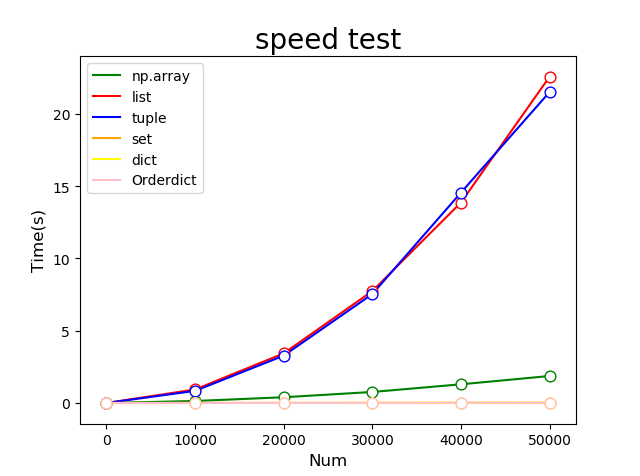Python3中in操作在列表,字典,集合中的速度对比2(改进版)
Python3中"in操作(x in X)"在列表list,字典dict,集合set,np.array 中的速度对比2(改进版)
我的原始文章链接:原始文章
上一个 实例(–>click传送门) 的对比不是很明显,主要是用单个元素在一个大空间内查找,太浪费资源了。
在这基础上,思考了一下,为何不用事先定义好的每一个元素就地查找呢。
改进版:
结论:集合和字典查找最快,其次为np.array,最慢的是list和tuple
运行结果:

代码:
# 对比某个元素在"列表/元组/字典/集合"的查找速度
# 结论:对于x in X的操作,集合字典在查找速度上有明显优势
import datetime
import numpy as np
import matplotlib.pyplot as mp
from collections import OrderedDict
def f(xx):
t0 = datetime.datetime.now()
for i in L:
if i in xx:
continue
t1 = datetime.datetime.now()
print('-->', type(xx), '遍历结束,耗时%s秒' % ((t1 - t0).total_seconds()))
return (t1 - t0).total_seconds()
X, y = [], []
n = 5*10**4
L_all = np.arange(0, n)
for x in range(0, n+1, 10000):
print('nx', x)
L = L_all[:x+1]
L_result = []
L_result.append(f(L))
L_result.append(f(list(L)))
L_result.append(f(tuple(L)))
L_result.append(f(set(L)))
L_result.append(f(dict(zip(L, [None] * len(L)))))
L_result.append(f(OrderedDict(zip(L, [None] * len(L)))))
X.append(x)
y.append(L_result)
mp.title('speed test', fontsize=20)
mp.xlabel('Num', fontsize=12)
mp.ylabel('Time(s)', fontsize=12)
for y, lable, colors in zip(
(np.array(y)).T,
['np.array', 'list', 'tuple', 'set', 'dict', 'Orderdict'],
['green', 'red', 'blue', 'orange', 'yellow', 'pink']):
mp.plot(X, y, linestyle='-', label=lable, color=colors)
mp.scatter(X, y,
marker='o', # 点型 ~ matplotlib.markers
s=60, # 大小
edgecolor=colors, # 边缘色
facecolor='white', # 填充色
zorder=3 # 绘制图层编号 (编号越大,图层越靠上)
)
mp.legend()
mp.show()
最后
以上就是幸福小猫咪最近收集整理的关于Python3中`in操作`在列表,字典,集合中的速度对比2(改进版)的全部内容,更多相关Python3中`in操作`在列表,字典,集合中内容请搜索靠谱客的其他文章。
本图文内容来源于网友提供,作为学习参考使用,或来自网络收集整理,版权属于原作者所有。








发表评论 取消回复